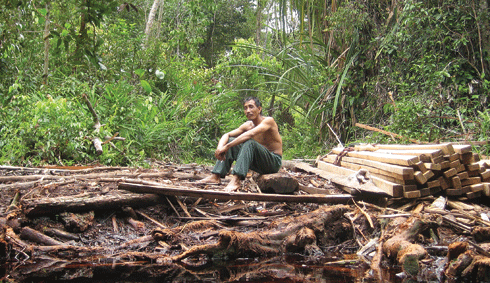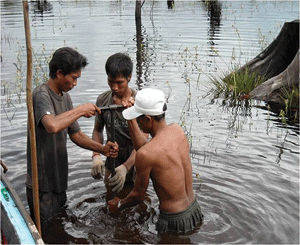
|
Published:
Forest benefits beyond counting carbon
The successor to the Kyoto Protocol is likely to include Reduced Emissions from Deforestation and Forest Degradation (REDD) provisions to reduce the damaging greenhouse gas emissions which occur from habitat destruction. But how can we calculate the carbon stored in habitats? And just how do REDD project developers prove they have prevented greenhouse gas emissions from happening? Zoe Harkin explains some of the technical challenges presented by this emerging field of work.

|
|
Satellite imaging technology and aerial surveys are part of the carbon stock estimation and measurement process in REDD projects. Credit: iStockphoto
|
In my role as Forest Carbon Specialist, I am often asked to explain how I measure the amount of carbon stored in a forest, and how much CO2 would be emitted if the same area were to be deforested. The techniques being used to assess these issues are rapidly evolving for the better.
To estimate the amount of emissions successfully prevented by a REDD project, one has to estimate what might have happened if the project hadn’t been implemented in the first place. This is known as the ‘baseline scenario’. The estimate could be based on the current rate of deforestation activities already occurring in the area, or it could involve an activity or effect predicted to occur in the future.
During the very early stages of REDD market development, after ~1996, the methods used for forecasting this baseline scenario were little more than guesswork. A few references to the scientific literature, supplemented with some commentary on the causes of deforestation at the site, used to suffice. As the voluntary carbon market has matured, however, the level of rigour and analysis required to forecast baseline activities has increased significantly.
Methods for calculating the baseline scenario now make use of complex remote sensing technologies and Geographic Information Systems (GIS) analysis, and are tailored depending on the key drivers of deforestation.
For example, the probability of unplanned (or unlawful) deforestation can be forecast by analysing factors such as distance to roads, population centres and sawmills, etc. Audit trails of documentation, such as management plans, now play an increasingly important role in calculating the exact time and location that the deforestation or degradation event would have occurred – or might occur. Such complex analyses then need to be submitted for independent verification before carbon credits can be issued for sale.
The science of measuring the carbon stock in trees (carbon biomass) themselves is well established, and accurate. Essentially a tree’s trunk diameter is recorded at breast height, and allometric equations – which calculate relative growth rates – are then used to estimate carbon accumulation levels over time with normal photosynthetic growth. Measuring avoided emissions takes into account other linked variables, such as the depth and carbon richness of a peat layer under a forest that would be exposed to carbon loss with deforestation.

|
|
An illegal logger at Ketapang, Kalimantan, with production timber that sustains his livelihood. Credit: Zoe Harkin, FFI
|
Additionality is a double-edged sword
To generate carbon credits, REDD projects must be able to prove that the emissions they have prevented are ‘additional’. For example, a project developer could not claim credit for carbon stored in a well managed and secure national park. The carbon stored in the habitat in question must be under threat from being released into the atmosphere by deforestation or degradation.
Almost all forest carbon standards on the voluntary carbon market today contain this ‘additionality’ requirement. It is usually coupled with the rule that REDD credits can only be claimed at the time at which the deforestation or degradation would have occurred (i.e. no ‘forward crediting’ – cashing in credits now for carbon saved in the future). What this means is, the sooner the deforestation would have occurred, the sooner the credits can be verified.
This approach has obvious advantages. Primarily, the additionality rule attracts REDD investment to the forests that are most at threat. On the flipside, forests that are most at threat are often the hardest (and arguably the most expensive) to save. And averting deforestation at the last minute is potentially expensive too. Thus, additionality is a ‘double-edged sword’ – REDD projects with strong additionality provide a more immediate revenue stream, but face higher risks and costs.
The ‘baby out with the bathwater’ problem
The commercial viability of REDD is highly sensitive to assumptions around the price of carbon. During these early stages of REDD market development, the assumed carbon price is quite low. As a result, marginal increases in project development costs can quickly make a potential REDD project unviable, or be considered too risky. This creates a ‘baby out with the bathwater’ problem – if the cost of developing a REDD project becomes too high, then many good prospective REDD projects will be abandoned before they even start.
This issue is particularly tricky given that the final rules and methodologies for implementation of REDD have yet to be decided. Project developers, therefore, do not yet know where they can afford to save on technical implementation costs.

|
|
Locals assist with the measurement of peat depth by core sample in a candidate REDD project area for Macquarie Carbon Forests Taskforce in Kalimantan, Indonesia. Credit: Zoe Harkin, FFI
|
Robbing Peter to pay Paul: the leakage problem
One of the major criticisms of REDD has been its potential to cause ‘leakage’ issues. This criticism comes from the concern that reducing deforestation in one forested area may simply shift some of the problem to another forested area. In effect, poorly designed REDD projects could end up ‘robbing Peter to pay Paul’.
There are two main solutions to the leakage problem. The first is to conduct carbon accounting on a national basis, thereby capturing all leakage effects within a single national reporting system. The second is to address the fundamental drivers of deforestation, rather than simply addressing the symptoms.
Light at the end of the tunnel ..
Implementing REDD can be challenging. However, the levels of avoided emissions expected from well designed and managed REDD projects are now easily calculated and can be monumental; for example, avoided emissions from a carbon-rich peat site under forest alone can be in the order of 20 to 50 tonnes CO2 per hectare per year.
Finally, through careful design and management, REDD has high potential to assist in addressing a suite of other global issues that have long eluded policy-makers, such as poverty alleviation, biodiversity conservation, and sustainable timber production and agriculture. The process stands to deliver true win-win outcomes – for the planet’s forests, for forest dependent communities, for biodiversity and for our global climate.
Zoe Harkin is a Forest Carbon Specialist with the Fauna & Flora International: Macquarie Carbon Forests Taskforce. For more information on Fauna & Flora International’s climate change work, visit www.fauna-flora.org.



